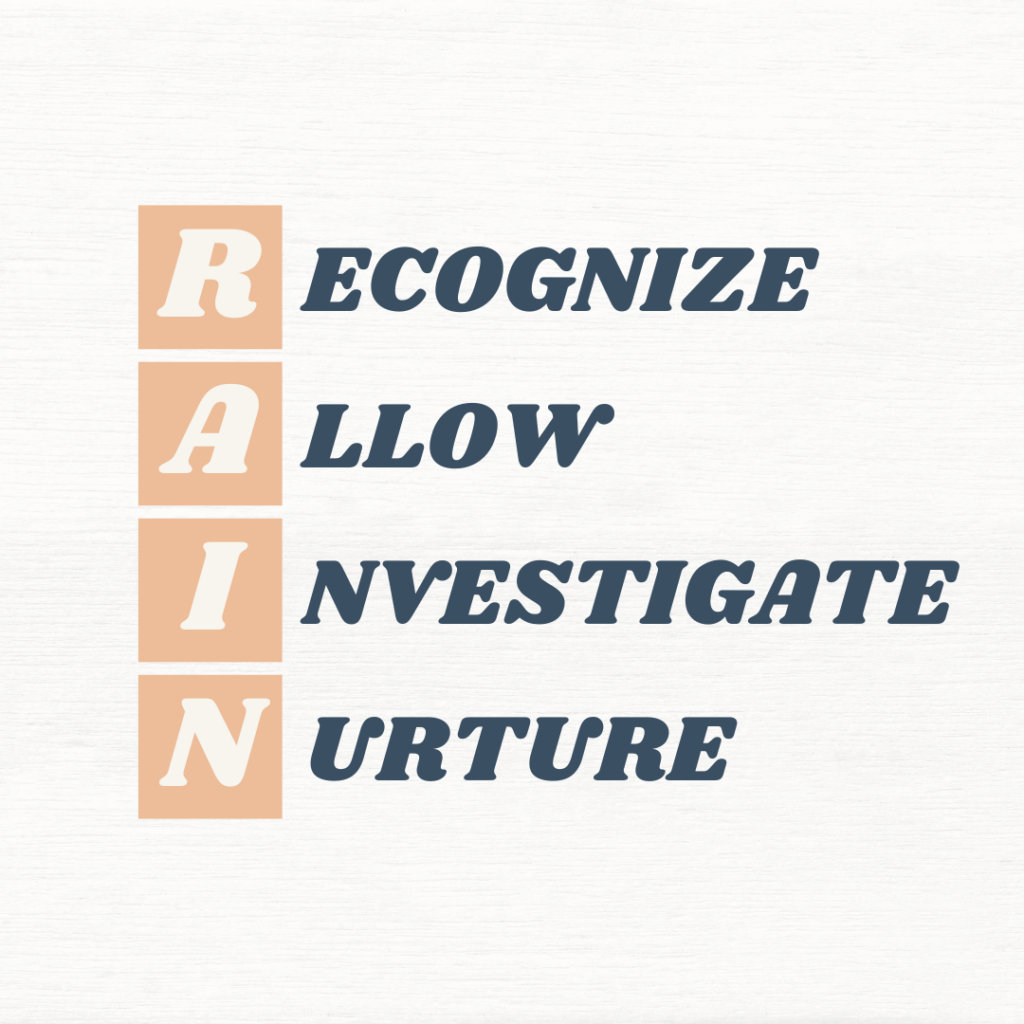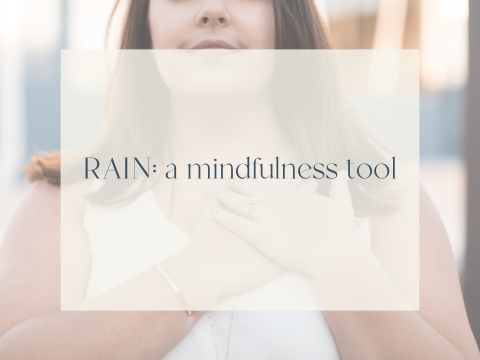Angela Prior
lcsw, ryt, ciec
hey there!
The AP blog is here for all things mental health, embodiment, yoga, and burnout. Poke around and take what you need.
meet angela
RAIN a mindfulness tool
August 29, 2024
One of my favorite tools and meditations to teach is RAIN. RAIN is a mindfulness tool for sitting, experiencing and moving through uncomfortable emotions. It is a 4 step acronym that stands for:

RAIN was first introduced in the early 2000s by Michele McDonald, co-founder of Vipassana Hawaii. Tara Brach, a psychologist, meditation teacher, and author made a few adjustments to the original RAIN acronym by shifting the N to nurture from non-identification. I prefer the use of Tara Brach’s adaptation and calling nurturing as a way to take action and invite in radical acceptance and compassion without judgment.
I personally use the N-nurture variation when I am teaching RAIN as a way to tie back the practice to the concept of caring for oneself.
The concept of RAIN is rooted in Buddhist psychology teachings regarding accepting emotions can help you find contentment and happiness. That when we push or avoid and push against an emotional experience it does not help us move through it faster or resolve the emotion. It only compounds the original emotion with layers of additional emotions such as anger, shame, despair, etc… That if we want to actually resolve an emotional experience or move through a feeling about something we need to be with that emotion and find acceptance.
Acceptance does not mean we like the emotion or the situation that elicits the emotion. It’s about finding radical acceptance; I can accept something I do not like. I can be with this feeling, name it, give permission for it, inquire why it is here, befriending or coexisting with this emotion, allowing me to care for it and myself. These steps then in turn allow me to access peace and contentment.
In a RAIN practice we explore an emotion that feels uncomfortable. I always instruct someone if this is their first time practicing RAIN that we do not pick the biggest more uncomfortable emotion or experience but one that is tender with a small amount of reactivity to it. The rationale for this is to not push you outside your window of tolerance (the amount of distress and discomfort you can tolerate) but gradually build and expand your tolerance through sitting with things that are uncomfortable.
Once you have the emotions for example I’m going to use dread. We would call up this emotion and an experience that elicits this response. For example: On Sunday nights I ,get the Sunday scaries and I start thinking about work and everything I need to get done. I feel stressed and I dread the work week.
To use RAIN you are going to move through the 4 steps as you apply this experience to them.

Recognize:
Begin to identify where your body feels sensations. Is there a correlating emotional name to the sensation? Naming and recognizing the emotion by saying the emotion out loud or silently in your mind.
Allow:
Give yourself permission to feel your emotion. Address your emotion like you would a loved one. Gently with empathy. Notice if you want to shut down the emotional experience. Say aloud or silently in your mind “io have permission to feel dread” “i am safe to feel dread”
“This feeling can not harm me”. Perhaps even mentally removing the internal barriers to experiencing the emotion.
Investigate with Kindness:
Calling up curiosity and empathy. Exploring with your emotion why it is here. Why is your emotion here? What does it need? Doing so with compassion, curiosity, and empathy. Exploring your experience without judgment and when judgment or critique arise gently nudge your thoughts away from the judgment.
Nurture:
As you have explored building empathy and compassion with yourself and your emotion begin to cultivate nurturing and care for yourself for your inner experience. Making space for your emotion without judgment and asking “What would be nurturing and kind to myself right now?”
As you move through this meditation you may find yourself feeling really stuck on one of the steps. You will stay at that step until you have experienced it fully. So if naminging the emotion feels sticky and difficult you stay here connecting with yourself and your sensations until you have named and identified the emotion then move on to Allow.
I know for me I struggled with understanding how to “sit with an emotion”. RAIN is a tool to help you experience what sitting with an emotion is like and how to access and feel your emotions without all the extra judgment and noise that can happen.

eight free meditations
To Support Your Mental Health
Let's Work Together
Meet Our Team of Therapists + Yoga Instructors